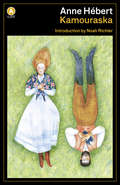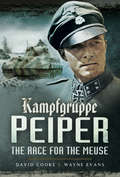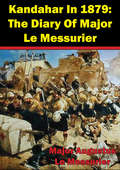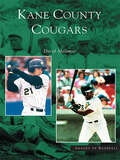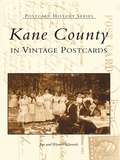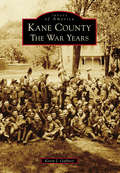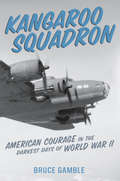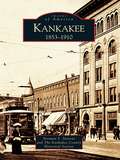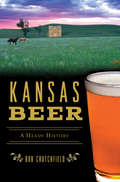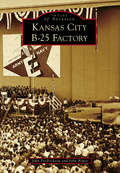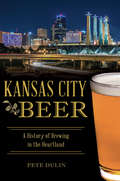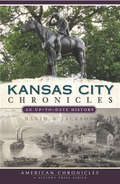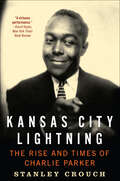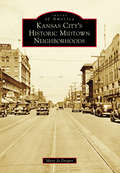- Table View
- List View
Kamouraska (A List)
by Anne HébertA classic of Canadian literature by the great Quebecoise writer, Kamouraska is based on a real nineteenth-century love-triangle in rural Quebec. It paints a poetic and terrifying tableau of the life of Elisabeth d'Aulnieres: her marriage to Antoine Tassy, squire of Kamouraska; his violent murder; and her passion for George Nelson, an American doctor. Passionate and evocative, Kamouraska is the timeless story of one woman's destructive commitment to an ideal love. Translated into seven languages, Kamouraska won the Paris book prize and was made into a landmark feature film by Claude Jutra. This edition features a brilliant new introduction by Noah Richler.
Kampfflieger: Bomber Crewman of the Luftwaffe 1939-45
by Adam Hook Robert StedmanThe Kampfflieger are relatively unknown within aviation circles, although many of them had careers as distinguished as those of their fighter-pilot counterparts. The men of the bomber crews did not enjoy the luxury of combat tours - they flew until they died or became unfit for combat duty. This book studies the attitudes, beliefs and motivation of the average crewman, following him through recruitment and training to experience on campaign in western Europe, Africa and the Russian front during World War II (1939-1945), detailing the exploits and trials of the famous Ju 87 'Stuka' dive-bomber crews and their own crucial part in Germany's war effort.
Kampfgeschwader 51 "EdelweiSS": The Complete History of KG 51 in World War II
by Wolfgang DierichRare unit history of a World War II Luftwaffe bomber unit
Kampfgruppe Peiper: The Race for the Meuse
by David Cooke Wayne Evans&“A fast paced story . . . If this is the only book you can buy of the Battle of the Bulge, this is the one to go for. Highly commended.&”—Firetrench On 16 December 1944 Hitler&’s last great offensive commenced, pushing through the difficult terrain of the Ardennes in Belgium. Its objectives were the Meuse bridges and, beyond them, Antwerp. Hitler&’s aim was to cut off the northern British and American armies and force them to surrender or retreat. At the forefront of the German assault was Kampfgruppe Peiper of the SS Leibstandarte Adolf Hitler Division. It was the most powerful force in the German order of battle. Travelling along roads hardly suitable for cars, let alone Tiger tanks, the kampfgruppe had to cross numerous streams and rivers to reach its objectives. It was delayed by a handful of American combat engineers who blew up bridges, then it was brought to a halt by American reinforcements. As the tide turned, the kampfgruppe fought for its life, holding out for several days in a desperate rearguard action against increasing odds. David Cooke and Wayne Evans use contemporary accounts and a wealth of maps and illustrations to tell the story of Kampfgruppe Peiper in unprecedented detail. &“This well written volume makes fascinating reading. The superb text is accompanied by a full walking and driving battlefield tour, making this publication an invaluable addition to any military enthusiast&’s library.&”—Roll of Honour
Kanada
by Eva WisemanKanada. The name meant untold riches and promise to Jutka, a young Hungarian girl who was captivated by stories of a vast, majestic country where people were able to breathe free of hatred and prejudice. Freedom was in short supply, but hatred was everywhere in Hungary as hundreds of thousands of Jews were deported to concentration camps during the last year of WWII. Jutka, her friends, and her family are sent to Auschwitz.In that hellish place, there was another Kanada. It was the ironic name given to the storehouse at Auschwitz where the possessions -- clothing and jewelry -- stripped from the victims were deposited, and where Jutka was put to work. The war may have ended, but it did not end the suffering of many of the inmates of concentration camps. Many had no homes to go to, and if they did, they were not welcome. Hundreds went back to Poland and were murdered. Famished, diseased, and homeless, they lived in the hopelessness of camps, wondering if they could ever find a home in the world. Some went to Israel, but for Jutka there was only one dream left her -- the dream of a country full of hope, where she would no longer have to live in fear.Eva Wiseman's powerful novel describes the war and its long, difficult aftermath with compassion and tenderness.From the Trade Paperback edition.
Kandahar In 1879: The Diary Of Major Le Messurier
by Major Augustus Le MessurierA remarkable diary from the wars of the British Empire of the historic march on Kandahar in 1879.The Second Anglo-Afghan war 1878-1880 was intended to establish peace and British hegemony to the North-West frontiers of the Indian Empire. After the brutal and disastrous effort of the British to invade during the first war (1842) the Afghans would not be underestimated and remained dangerous on their own territory. The British, quick to realize that another reverse in this country would signal an end to their prestige and influence, organize a relief effort. Formed into three columns, the troops were well prepared and commanded by veteran generals, each setting out to pacify a different area of the country.Major Augustus Le Messurier was appointed brigade major of the Royal Artillery attached to the Kandahar Field Force, one of the invading columns under the command of Lt.-Gen. D. M. Stewart. The terrain that the Kandahar field force had to cover was among the toughest in the world, and constantly harassed by irregulars, hunger, cold they made Kandahar by dint of superhuman efforts.
Kandathil Varghese Mappillai
by C. J. RoyThe present work is a monograph on Kandathil Varghese Mappilai (1857-1904), an outstanding writer cum journalist who made significant contribution to the development of Malayalam literature.
Kane County Cougars (Images of Baseball)
by David MalamutIn 1991, it seemed odd (if not unwise) when a minorleague franchise moved into a major league market--one with two big league teams, no less. But the storyof the Kane County Cougars of the single-A MidwestLeague has been one of tremendous successes onthe field, at the gates, and above all in the hearts ofbaseball fans in Chicago's western suburbs. The teamcontinues to draw more than half a million fans toGeneva's cozy Elfstrom Stadium year after year, without ever being affiliated with the Cubs or Sox in the nearby city. They have fielded some top prospects, including 2003 World Series MVP Josh Beckett and his teammate Dontrelle Willis. They have battled in the post-season several times in their brief history, and they thrilled fans by winning the 1991 Midwest League Championship. Cougar fans will enjoy this pictorial tour through the club's first 15 seasons, which provides a local view of the history of the national pastime.
Kane County in Vintage Postcards (Postcard History)
by Jim Edwards Wynette EdwardsRich land at the edge of a great prairie with the wonderful Fox River flowing through it, providing a source of power-this is what the settlers of Kane County found when they arrived. Early pioneers came from the eastern United States in the 1830s, and later migrated from Europe. Kane County in Vintage Postcards tells the story of the beginning of Kane County through its first 100 years, 1838 through 1938, featuring images of that period.This new history of Kane County includes an essay on the importance of postcards as historical data, a general history of the county, and a section-by-section look at 27 cities and villages. More than 200 pictures and colorful narratives tell of the accomplishments by those first few generations who lived and died in the county.
Kane County: The War Years (Images of America)
by Kevin J. GaffneyThe declaration of war in 1917 and the attack on Pearl Harbor by the Japanese on December 7, 1941, stirred the men and women of Kane County, Illinois, to action and service. In World War I, many in Kane County joined the Illinois National Guard 3rd Regiment, 65th and 66th Brigades, and 129th and 131st Infantries of the 33rd Infantry Division. Many of the men also served in the infantry regiments of the 1st Division, known also as the “Big Red One.” They trained for war in places like Camp Deneen in Elgin, Camp Grant in Rockford, and Camp Logan in Houston, Texas. In World War II, Kane County’s men performed on the war’s biggest stages, aiding in Operation Torch, Operation Husky, and the invasion of Normandy. The women of Kane County also served overseas in both world wars as Red Cross nurses and WAVES, and domestically, they worked in factories, supporting in many vital ways.
Kang Youwei Engages India: His Travel Narratives (1901–1902) and Predicaments of Civilization and Nation
by Kamal Sheel Ranjana SheelThis book is the first annotated translation of the travelogues of Kang Youwei, one of the most famous intellectuals and modernisers of late 19th-century China. These travelogues offer insights into Kang’s perceptions of India, which influenced modern intellectual discourse on India in China. These perceptions not only had a great impact on the thinking of other intellectuals but were also responsible for the larger construct that China developed about India during the republican and post-liberation period. The texts provide meaning to many dilemmas and predicaments that enshrouded the concept of civilisation and its linkages with the modern concepts of nationalism and modernity in Asian countries such as China and India. They are a valuable prism in gauging the early 20th-century intellectual and Chinese moderniser mind as it grappled with the challenges and uncertainties of those times. An important contribution to the study of Sino-Indian interactions, the book will be an indispensable resource for students and researchers of nation, nationalism, civilisation, empire, modern history, translation studies, Chinese Studies, and Asian studies.
Kang Youwei Engages India: His Travel Narratives (1901–1902) and Predicaments of Civilization and Nation
by Kamal Sheel Ranjana SheelThis book is the first annotated translation of the travelogues of Kang Youwei, one of the most famous intellectuals and modernisers of late 19th-century China. These travelogues offer insights into Kang’s perceptions of India, which influenced modern intellectual discourse on India in China. These perceptions not only had a great impact on the thinking of other intellectuals but were also responsible for the larger construct that China developed about India during the republican and post-liberation period. The texts provide meaning to many dilemmas and predicaments that enshrouded the concept of civilisation and its linkages with the modern concepts of nationalism and modernity in Asian countries such as China and India. They are a valuable prism in gauging the early 20th-century intellectual and Chinese moderniser mind as it grappled with the challenges and uncertainties of those times. An important contribution to the study of Sino-Indian interactions, the book will be an indispensable resource for students and researchers of nation, nationalism, civilisation, empire, modern history, translation studies, Chinese Studies, and Asian studies.
Kangaroo Squadron: American Courage in the Darkest Days of World War II
by Bruce GambleIn early 1942, while the American military was still in disarray from the devastating attacks on Pearl Harbor and the Philippines, a single U.S. Army squadron advanced to the far side of the world to face America's new enemy.Based in Australia with inadequate supplies and no ground support, the squadron's pilots and combat crew endured tropical diseases while confronting numerically superior Japanese forces. Yet the outfit, dubbed the Kangaroo Squadron, proved remarkably resilient and successful, conducting long-range bombing raids, carrying out armed reconnaissance missions, and rescuing General MacArthur and his staff from the Philippines.Before now, the story of their courage and determination in the face of overwhelming odds has largely been untold. Using eyewitness accounts from diaries, letters, interviews, and memoirs, as well as Japanese sources, historian Bruce Gamble brings to vivid life this dramatic true account.But the Kangaroo Squadron's story doesn't end in World War II. One of the squadron's B-17 bombers, which crash-landed on its first mission, was recovered from New Guinea after almost seventy years in a jungle swamp. The intertwined stories of the Kangaroo Squadron and the "Swamp Ghost" are filled with thrilling accounts of aerial combat, an epic survival story, and the powerful mystique of an invaluable war relic.
Kankakee: 1853-1910
by The Kankakee County Historical Society Norman S. StevensKankakee became the county seat when Kankakee County was established in 1853. The largest city in the county, Kankakee embraced the railroad from its 19th-century beginning, becoming an important railroad hub in Illinois. The Kankakee County Historical Society has long worked to preserve the city's history and it celebrates its 100th anniversary in 2006, making it one of Illinois' oldest historical societies. The images in this book come from the society's large collection and they represent many slices of Kankakee life from 1853 to 1910.
Kannani and Document of Flames: Two Japanese Colonial Novels
by Yuasa KatsueiThis volume makes available for the first time in English two of the most important novels of Japanese colonialism: Yuasa Katsuei's Kannani and Document of Flames. Born in Japan in 1910 and raised in Korea, Yuasa was an eyewitness to the ravages of the Japanese occupation. In both of the novels presented here, he is clearly critical of Japanese imperialism. Kannani (1934) stands alone within Japanese literature in its graphic depictions of the racism and poverty endured by the colonized Koreans. Document of Flames (1935) brings issues of class and gender into sharp focus. It tells the story of Tokiko, a divorced woman displaced from her Japanese home who finds herself forced to work as a prostitute in Korea to support herself and her child. Tokiko eventually becomes a landowner and oppressor of the Koreans she lives amongst, a transformation suggesting that the struggle against oppression often ends up replicating the structure of domination. In his introduction, Mark Driscoll provides a nuanced and engaging discussion of Yuasa's life and work and of the cultural politics of Japanese colonialism. He describes Yuasa's sharp turn, in the years following the publication of Kannani and Document of Flames, toward support for Japanese nationalism and the assimilation of Koreans into Japanese culture. This abrupt ideological reversal has made Yuasa's early writing--initially censored for its anticolonialism--all the more controversial. In a masterful concluding essay, Driscoll connects these novels to larger theoretical issues, demonstrating how a deep understanding of Japanese imperialism challenges prevailing accounts of postcolonialism.
Kansas And The West: New Perspectives
by Rita NapierKansas is steeped in the lore and legends of the Old West-from Dodge City to the Dust Bowl days. But, as these authors show, that leaves out a lot of state history. Drawing on scholarship that has transformed our understanding of the history of both state and region, Kansas and the West introduces readers to a wide range of people, places, and themes that demonstrate the complex relationships among race, class, gender, and environment. In so doing, it also puts to rest many of the myths that have dominated western history for so long, reflecting both the positive and the negative consequences of human actions over 150 years of Kansas history. The collection gathers eighteen key writings that take readers through three eras. The dispossession and resettlement of Native Americans is seen in such pieces as Elliot West's "Story of Three Families" and Richard White's "Cultural Landscape of the Pawnees." The nineteenth-century evolution from "Bleeding Kansas" to a modern state is seen in works ranging from writings on the Civil War era by Bill Cecil-Fronsman and Richard Sheridan to observations on road improvements by Paul Sutter. And selected aspects of Kansas in the twentieth century are seen in such contributions as Donald Worster's controversial views on the Dust Bowl, Mary Dudziak's article on desegregation in 1950s Topeka, and a look at labor in the beefpacking industry by Donald Stull and Michael Broadway. By incorporating voices from history that have too long been lost in the din of tradition—especially the voices of Native Americans and blacks, women and laborers—Kansas and the West provides a provocative and much-needed new view of the state's past. A book that will prove fascinating for general readers, instructive for students, and an invaluable touchstone for scholars, it brings us different stories, new actors, and fresh images that challenge some of our most cherished views of the West—and in the process shows us that complexity and diversity have always characterized what we have habitually thought of as "simpler times."
Kansas Baseball (Sports)
by Michael J. TravisBaseball has long been synonymous with Kansas. Go back to the late 1800s and the birth of Walter Johnson and George Sweatt, Humboldt kids who played baseball at the highest level but in different leagues due to racism. Learn about the sixteen-year-old signed by the Kansas City Athletics, who left the University of Kansas campus to play his first game at Municipal Stadium the next day. Read about pioneers in the game named Joyce, Katie and Alex, determined and talented women who are part of our national pastime. Author Michael Travis shares his love for the game, rounding the bases from its beginnings in Wichita with League 42 to the Major Leagues.
Kansas Beer: A Heady History (American Palate)
by Bob CrutchfieldProhibition came early to Kansas in 1881, driving more than 125 breweries out of business or underground. Refusing to even vote on the 1933 national repeal, the state remained dry until 1948, with liquor by the drink finally being approved in 1987. Lawrence's Chuck Magerl worked with the legislature to pen new laws allowing something (little known at the time) called a "microbrewery." Chuck started the state's first brewery in over a century, appropriately named Free State Brewing Company. John Dean of Topeka's Blind Tiger Brewery counts more awards than any other brewer in the state, including Champion Brewer at the World Beer Cup in 2014. Props & Hops Brewing, in tiny Sylvan Grove, is owned and operated by an enterprising pilot who also owns and operates a crop-dusting business on the weekdays. Author Bob Crutchfield explores the state's breweries and recounts the Sunflower State's hoppy history.
Kansas Brides: The Town of Cedar Springs is Home to Four Marriage Conflicts
by Denise HunterOn the historic plains, four women find someone to marry. Will these brides blossom like sunflowers in the prairie heat or wither under the pressures of marriage? Is it really love when. . . Sara's trying to escape an abusive stepfather, and her groom marries to please his father? Jane wonders if the marriage proposal she's received is Luke's reaction to the love he just lost? Jane's own sister? Mara collects suitors like some women collect teacups--though not the one man she really wants? Emily says "I do" with the dream of having children but finds her husband has no such desire? Will these marriages ripen to a full harvest of love or will they produce only chaff scattered on the wind? Can these women trust God to orchestrate their lives and loves?
Kansas City B-25 Factory (Images of Aviation)
by John Fredrickson John RoperAn industrial miracle took place at the Fairfax Airport, on the shores of the Missouri River, between 1941 and 1945. A massive factory was quickly built and a large modification center was soon added. At its peak, over 24,000 greater Kansas City-area residents were employed by North American Aviation, Inc. Their goal was to build as many twin-engine B-25 Mitchell medium bombers for wartime service as possible. Their success was the construction of an unprecedented 6,608 aircraft. The B-25 Mitchell served with distinction in every theater of World War II, and significant numbers of them were provided to Allied nations. Many B-25s have been preserved, and some of them remain airworthy today. They can be seen on static display or in flight at air shows all across America.
Kansas City Beer: A History of Brewing in the Heartland (American Palate)
by Pete DulinWestbound immigrants, pioneers and entrepreneurs alike arrived in Kansas City with a thirst for progress and beer. Breweries both small and mighty seized opportunity in a climate of ceaseless social change and fierce regional competition. Muehlebach Brewing Company commanded the market, operating in Kansas City for more than eighty years. Built in 1902, the iconic brick warehouse of Imperial Brewing still stands today. Prohibition made times tough for brewers and citizens in the Paris of the Plains, but political "Boss" Tom Pendergast kept the taps running. In 1989, Boulevard Brewing kicked off the local craft beer renaissance, and a bevy of breweries soon formed a flourishing community. Food and beer writer Pete Dulin explores Kansas City's hop-infused history and more than sixty breweries from the frontier era to the twenty-first century.
Kansas City Chronicles: An Up-to-Date History
by David W. JacksonFrom guerilla warfare and martial law to the elegant dresses of the Harzfeld Parisian Cloak Company, discover how everything became up-to-date in Kansas City (including the phrase "up-to-date"? itself, which predates the song in Oklahoma!). Watch as the Jackson County Poor Farm became the state-of-the-art Truman Medical Center and learn why Old Westport is the real McCoy. Meet the resident mouse of the Laugh-O-Gram studio on Thirteenth and Forest, which took food from Walt Disney's hand as Mortimer before taking shape on Disney's drawing board as Mickey. In this collection of his best historical columns, David Jackson delivers a vivid portrait of the people, places and events that continue to shape this fascinating town.
Kansas City Lightning: The Rise and Times of Charlie Parker
by Stanley Crouch“A tour de force . . . Crouch has given us a bone-deep understanding of Parker’s music and the world that produced it. In his pages, Bird still lives.” —Washington PostA stunning portrait of Charlie Parker, one of the most influential musicians of the twentieth century, from Stanley Crouch, one of the foremost authorities on jazz and culture in America.Throughout his life, Charlie Parker personified the tortured American artist: a revolutionary performer who used his alto saxophone to create a new music known as bebop even as he wrestled with a drug addiction that would lead to his death at the age of thirty-four.Drawing on interviews with peers, collaborators, and family members, Stanley Crouch recreates Parker’s childhood; his early days navigating the Kansas City nightlife, inspired by lions like Lester Young and Count Basie; and on to New York, where he began to transcend the music he had mastered. Crouch reveals an ambitious young man torn between music and drugs, between his domineering mother and his impressionable young wife, whose teenage romance with Charlie lies at the bittersweet heart of this story.With the wisdom of a jazz scholar, the cultural insights of an acclaimed social critic, and the narrative skill of a literary novelist, Stanley Crouch illuminates this American master as never before.“A virtuous performance.” —David Hajdu, New York Times Book Review“A magnificent achievement; I could hardly put it down.” —Henry Louis Gates, Jr.“Insightful, profound, and wholly original.” —Wynton Marsalis“A jazz biography that ranks with the very best.” —Booklist, starred review“In prose that veers toward lyrical rapture, [Crouch] conjures the inner life of the improvising artist.” —The New Yorker
Kansas City Southern Railway
by Thad Hillis CarterThe Kansas City Southern Railway initially offered freight service to the immediate Kansas City area south. As the line expanded toward Texas, each tiny community had its own railway station with access to daily passenger service and less-than-carload lot freight services. No one could have foreseen that the road would eventually haul international import and export goods or that its line would reach into Mexico. Photographs in this book include the railway's involvement in operating steam engines over its lines as well as pictures from the files of esteemed rail photographers Harold K. Vollrath and Gary Coates.
Kansas City's Historic Midtown Neighborhoods
by Mary Jo DraperThe unique character of Midtown--from Thirty-first to Fifty-fifth Streets, State Line to the Paseo--grew out of its development as the streetcar suburbs of an expanding Kansas City. As residents both rich and poor moved out of the crowded downtown area after 1880, Midtown neighborhoods were built. The first wave brought mansions to major streets such as Armour Boulevard, Troost Avenue, and Broadway Boulevard, and later a housing shortage spurred the development of Midtown's unique apartment buildings. Well-known architects and local developers created bungalows, shirtwaists, and tree-lined residential streets. Churches and schools, business districts, movie theaters, and other entertainment venues quickly followed residents in their migration to the "south side." By the 1940s, Midtown's growing residential districts had developed into today's popular neighborhoods, including Center City, Coleman Highlands, Countryside, Crestwood, Heart of Westport, Hyde Park, Manheim Park, Old Hyde Park, Plaza-Westport, Rockhill, Volker, Roanoke, South Plaza, Southmoreland, Squier Park, Sunset Hill, Troostwood, Valentine, West Plaza, and Westwood Park.
